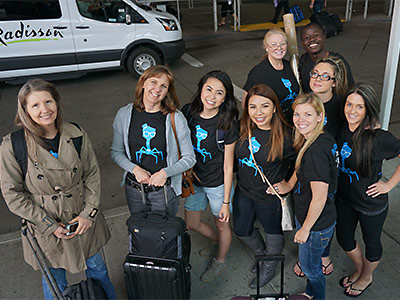
Microbiology students and faculty travel to Community College Undergraduate Research Initiative (CCURI) Symposiums to share research, and to network (shown here in Phages T-shirts).
Biology Professor Laura Briggs, PhD and Science Lab Coordinator Tina Slowan-Pomeroy raise expectations and positive experiences for students—they are not satisfied to let young scientists out of the door without having experienced undergraduate research firsthand.
Briggs and Slowan-Pomeroy lead students in the discovery of bacteriophages—studies of viruses that infect bacteria. The microbiology research at Truckee Meadows Community College is a depth of study that has been, for the most part, unheard of at two-year schools until now.
The two educators say that students who are involved in their own laboratory investigations continue in science with more confidence and conviction, and the TMCC faculty members have recently been published in a prestigious journal concerning this innovative topic. They are contributors to a national data set showing how undergraduate research inspires students to persist in science coursework.
“Undergraduate research is a huge motivator, the whole premise for what they do in their studies is that they have ownership,” Slowan-Pomeroy said. “If students go into the second half of the microbiology research course offered at TMCC, they get to analyze the genome of the phage they found in the first half. They get to name their phage, within some naming guidelines, and the students also are able to present their work at symposiums.”
Dr. Briggs agrees.
“Students get a lot more confidence when they know the work was done by them, and not an experiment assigned by their instructor for which they already know the outcome,” she said. “They get that extra spark of confidence. Once they’re done with an undergraduate research project, they believe in themselves more than they did when they began.”
Data that Briggs and Slowan-Pomeroy have gathered was included in findings published in the Proceedings of the National Academy of Sciences article. The research paper is “An inclusive Research Education Community (iREC): Impact of the SEA-PHAGES program on research outcomes and student learning,” published November 2017.
Contributors to the paper come from across the U.S. The article is sponsored by William R. Jacobs, Jr., PhD, Professor of Microbiology and Immunology and Genetics at Albert Einstein College of Medicine. It has gone through a rigorous peer-review process.
TMCC students have been involved in the discovery and genetic mapping of phages since 2014, and their post-research survey responses add qualitative data for the larger paper.
What is a Phage, and Why is this Work Important?
Bacteriophage, or phage require a bacterial host in order to reproduce, and are named according to the strain of bacteria they infect.
Phage can kill bacteria, and may eventually be used to treat antibiotic-resistant bacterium that are harmful to humans and other animals. Knowledge of bacteriophage will benefit the fields of human medicine, veterinary medicine, and agriculture.
Seven four-year U.S. colleges and universities—and one community college, TMCC—were accepted into the Howard Hughes Medical Institute Science Education Alliance PHAGES project for the 2014-2015 school year. Since that time, students have worked to gather, isolate, and purify bacteriophages in environmental samples during Fall Semesters, and complete bioinformatics work analyzing the phages’ sequenced genomes during the spring semesters.
There are currently 11 cohort groups working on this at about 160 schools, more than 4,000 undergraduate students contributing to the SEA-PHAGES project.
“There were not even a hundred phages isolated before SEA-PHAGES,” Briggs said. “Now more than 12,000 have been isolated, with one-fourth of those—about 2,433—having even been sequenced,” Briggs said.
An inclusive Research Education Community (iREC) is a college learning group of instructors and students dedicated to doing research in class rather than repeating previously completed “cookbook recipe” lab experiments. The concept of iREC is gaining momentum in higher education.
“If you have a hypothesis, and you’re on the fly, not knowing what the results will be, it’s more meaningful, even though it’s more challenging,” Briggs said. “In addition, there is so much to be done that all the laboratories in all the world, working all the time, couldn’t even approach this never-ending work.”
The thinking is that professors take research and put it in the classroom for the benefit of both students and society.
“Why not let this huge workforce be put to work,” Briggs added. “This teaming up of education and research results in more than anyone thought could ever be done.”
Real Results for Students
Briggs and Slowan-Pomeroy have found that the data on learning outcomes support what they have already observed in the classroom; students doing undergraduate research persist in science courses.
“I didn’t do any real research until I had my bachelor’s degree,” Slowan-Pomeroy said. “Our students go through the lab, and after that they have the opportunity to become an instructional assistant. A couple of students continue on to become instructional assistants and teach new students what they just learned.”
After their Fall Semester BIOL 251: Microbiology course isolating new phages, the students take an online survey. They respond to questions concerning the following six measures:
- Personal ownership and engagement to research conducted in class
- The degree of “positive emotive response” to their research
- How confident students feel functioning as a scientist
- To what extent they think about themselves as scientists
- Their affinity to values of the scientific community
- How much they talk about their research in personal and professional networks
Prior research has shown that the higher students score on these six measures, the more they will persist and take further science courses.
“The data created from the surveys shows the effectiveness of research as a teaching tool,” Briggs said.
For more information about the SEA-PHAGES project and microbiology classes at TMCC, please contact Laura Briggs at 775-673-7257, or Tina Slowan-Pomeroy at 775-674-7916.






